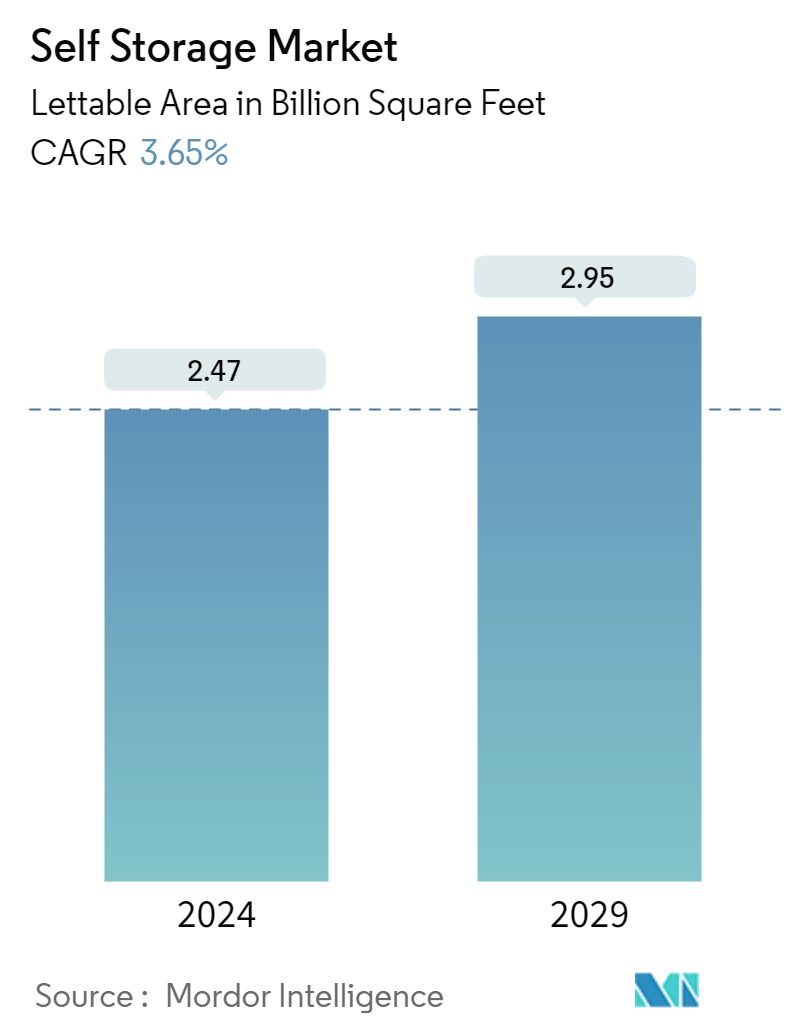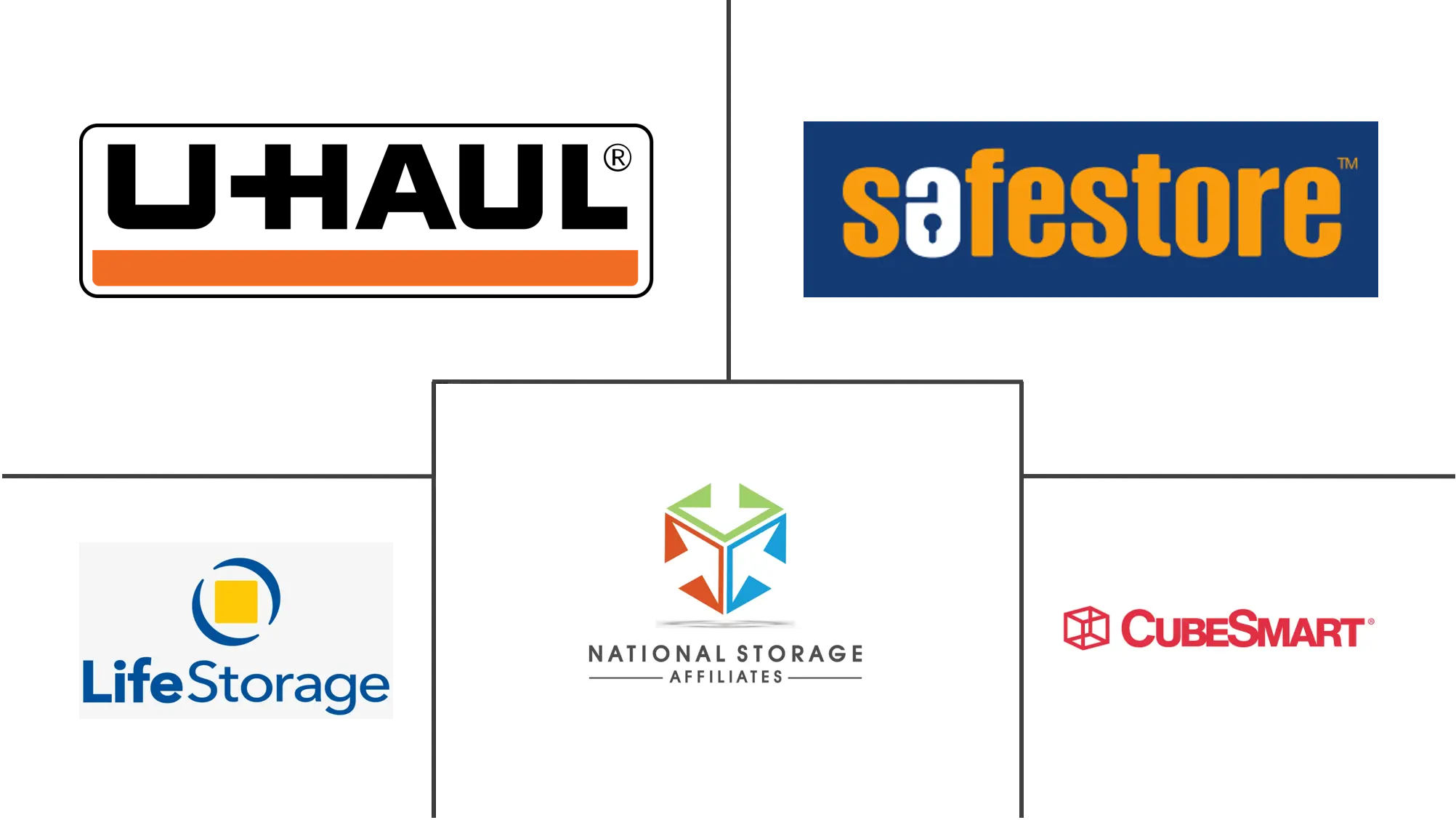
| Study Period | 2019 - 2029 |
| Market Volume (2024) | 2.47 Billion square feet |
| Market Volume (2029) | 2.95 Billion square feet |
| CAGR (2024 - 2029) | 3.65 % |
| Fastest Growing Market | Asia Pacific |
| Largest Market | North America |
| Market Concentration | Low |
Major Players
*Disclaimer: Major Players sorted in no particular order |
Self Storage Market Analysis
The Self Storage Market size in terms of lettable area is expected to grow from 2.47 Billion square feet in 2024 to 2.95 Billion square feet by 2029, at a CAGR of 3.65% during the forecast period (2024-2029).
- The self-storage sector, a segment within commercial real estate, is set for robust growth driven by urbanization and improving economies. While established markets like the United States and Western Europe boast well-developed self-storage infrastructures, regions such as China and India are witnessing the nascent stages of this concept.
- Urbanization, accompanied by increasing urban populations, is a primary growth factor. As cities grow with denser populations and rising real estate prices, the demand for self-storage, particularly among renters, is rising. For instance, London's population hit 9.7 million in 2024, which is projected to reach the 10 million mark by 2030.
- Businesses are aware of storage costs and are increasingly turning to self-storage solutions. Unlike traditional warehousing, self-storage offers businesses a wider array of space sizes and pricing plans. The market has been registering a significant advancement in the development of climate control and digital security-managed self-storage facilities to provide tenants with safe storage facilities for their belongings against environmental factors, including temperature and humidity, among others, supporting the growth of the market by creating an opportunity for the climate control feature based self-storage facilities.
- Highlighting this trend, in December 2023, VanWest Partners, a real estate investment firm specializing in self-storage, unveiled plans for a project in Denver, Colorado. The project, to be managed by their subsidiary, ClearHome Self Storage, will feature a 5-story, 93,000-square-foot building of Class A, climate-controlled self-storage units. This move addresses the surging demand for climate-controlled storage in the United States. During the forecast period, it signals a strategic response to the growing need for climate-neutral storage solutions catering to business and personal clientele.
- However, the industry faces challenges from government regulations. The Department of Homeland Security has cautioned operators about potential misuse of their facilities for storing materials that could pose security risks.
Self Storage Industry Segmentation
Self-storage is an industry that rents storage space, such as rooms, locker rooms, containers, and outdoor space, also known as "storage units," to tenants, usually on a short-term basis, often month to month. Self-storage is available for individuals and small and medium-sized businesses in flexible, shorter, or longer periods. Self-storage facilities are highly professional and are different from empty warehouses or attics. Self-storage centers are fitted with all the necessary equipment to ensure secure storage of goods. The concept of self-storage comes from the United States, but it's also spreading to Europe.
The self-storage market is segmented by user type (personal and business) and geography (North America [United States, Canada], Europe [United Kingdom, Germany, France, Spain, Italy, Benelux, Nordics, and the Rest of Europe], Asia-Pacific [China, Japan, Taiwan, South Korea, Malaysia, Hong Kong, Australia, and the Rest of Asia-Pacific], Latin America, Middle East and Africa). The study tracks the number and total lettable area of self-storage facilities worldwide, indicating their occupancy rate.
| Personal |
| Business |
| North America | United States |
| Canada | |
| Europe | United Kingdom |
| Germany | |
| France | |
| Spain | |
| Italy | |
| Belgium | |
| Netherlands | |
| Luxembourg | |
| Denmark | |
| Finland | |
| Norway | |
| Sweden | |
| Iceland | |
| Asia | China |
| Japan | |
| Taiwan | |
| South Korea | |
| Malaysia | |
| Hong Kong | |
| Australia and New Zealand | |
| Latin America | |
| Middle East and Africa |
Self Storage Market Size Summary
The self-storage market is poised for significant expansion, driven by urbanization and economic improvements. As cities become more densely populated and real estate prices rise, the demand for self-storage solutions is increasing, particularly among renters and businesses. The sector is experiencing advancements in climate control and digital security, enhancing the appeal of self-storage facilities. Regions like China and India are in the early stages of adopting self-storage, while established markets such as the United States and Western Europe have well-developed infrastructures. The market is also witnessing a shift towards technologically advanced solutions, with millennials favoring digital interactions and features like virtual tours and contactless payments. This trend presents opportunities for new entrants to disrupt the market by leveraging technology to meet evolving consumer expectations.
North America, led by the United States and Canada, is expected to dominate the self-storage market due to rising demand for storage solutions and industrial automation. The region's focus on reducing infrastructure costs and the need for real-time data availability are key drivers of growth. The market is highly competitive, with major players engaging in partnerships, acquisitions, and expansions to maintain their positions. Investments in the sector are increasing, supported by steady job creation and wage growth, which boost household formation and consumer spending. The market's growth is further fueled by the demand for self-storage units among businesses and individuals, as well as the rising population densities in urban areas.
Self Storage Market Size - Table of Contents
1. MARKET DYNAMICS
-
1.1 Market Drivers
- 1.1.1 Increased Urbanization Coupled with Smaller Living Spaces
- 1.1.2 Changing Business Practices and COVID-19 Consumer Behavior
-
1.2 Market Restraints
- 1.2.1 Government Regulations on Storage are Hindering the Market Growth
2. MARKET SEGMENTATION
-
2.1 By User Type
- 2.1.1 Personal
- 2.1.2 Business
-
2.2 By Geography***
- 2.2.1 North America
- 2.2.1.1 United States
- 2.2.1.2 Canada
- 2.2.2 Europe
- 2.2.2.1 United Kingdom
- 2.2.2.2 Germany
- 2.2.2.3 France
- 2.2.2.4 Spain
- 2.2.2.5 Italy
- 2.2.2.6 Belgium
- 2.2.2.7 Netherlands
- 2.2.2.8 Luxembourg
- 2.2.2.9 Denmark
- 2.2.2.10 Finland
- 2.2.2.11 Norway
- 2.2.2.12 Sweden
- 2.2.2.13 Iceland
- 2.2.3 Asia
- 2.2.3.1 China
- 2.2.3.2 Japan
- 2.2.3.3 Taiwan
- 2.2.3.4 South Korea
- 2.2.3.5 Malaysia
- 2.2.3.6 Hong Kong
- 2.2.3.7 Australia and New Zealand
- 2.2.4 Latin America
- 2.2.5 Middle East and Africa
Self Storage Market Research FAQs
How big is the Self Storage Market?
The Self Storage Market size is expected to reach 2.47 billion square feet in 2024 and grow at a CAGR of 3.65% to reach 2.95 billion square feet by 2029.
What is the current Self Storage Market size?
In 2024, the Self Storage Market size is expected to reach 2.47 billion square feet.


